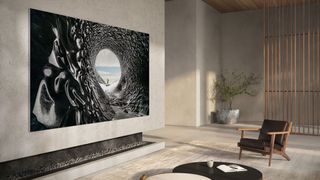Samsung's OLED-beating micro-LED 4K TVs are further away than we hoped
Next-gen TV tech will be giant-size only (and too expensive for most) for a few years yet

The next big thing in the world of screens is micro-LED. This technology works like OLED, in that each pixel generates its own light, and it made its big TV debut in a 110-inch set from Samsung in 2021, with smaller sizes set to follow.
But these smaller sizes didn't appear. So in 2022, Samsung announced a new range of sizes, but these haven't happened either – and according to a report in Digitimes, we shouldn't expect much until 2024-2025.
According to the report, the original plan to produce micro-LED TVs in 76-, 88-, 96- and 110-inch sizes was delayed due to pandemic-related closure of manufacturing plants in Vietnam, so Samsung shifted its production plans to South Korea for 2022, and planned an 89-inch version, a 101-inch version and a 114-inch model. But production of the 89-inch version has been pushed to later in the year, and the report says no decision has been made on launching the larger models yet.
In that year, Samsung's expected pricing for the micro-LED TVs dropped about 40%, which is great… but still meant that the likely price for the 89-inch micro-LED TV would be about $80,000.
The only size remotely suitable for 'normal' sized-homes in any of Samsung's micro-LED plans so far has been the 76-inch model, but that never happened – and won't be back soon, it sounds like. If you saw Samsung's original 2021 announcement and hoped that these models would quickly drop in price to become viable alternatives to the best 4K TVs, then you've got some time to wait still.
Analysis: why is micro-LED a big deal?
The reason micro-LED has TV nerds like me so excited is that it delivers all the benefits of the best OLED TVs without any downsides. You get the same per-pixel dimming as OLED, so you get the infinitely deep black levels and precise contrast, except micro-LED screens should be able to go much brighter. Today's top OLED TVs can just about hit 1,000 nits of brightness, but Samsung said it expects its first micro-LED TVs to hit around 4,000 nits of the brightness, and that around 10,000 nits could be possible in the future. This means you'd get far, far superior HDR from micro-LED than OLED ever looks to be capable of offering.
Micro-LED is also made from longer-lasting artificial materials, rather than the more delicate organic material of OLED, meaning you should get longer lasting screens without burn-in issues (which today's OLED TVs have largely overcome, to be fair).
Get the best Black Friday deals direct to your inbox, plus news, reviews, and more.
Sign up to be the first to know about unmissable Black Friday deals on top tech, plus get all your favorite TechRadar content.

But micro-LED is still bleeding-edge tech. All of these huge TVs Samsung has announced are only 4K, for example, whereas as Samsung flagship large mini-LED TVs, such as the Samsung QN900B, are 8K – and cost about 10% of what the micro-LED TV does at the same time.
Micro-LED is being used in products, but it's almost entirely in advanced digital signage for businesses. In fact, Samsung's first micro-LED product for the home, called The Wall, is basically just a series of micro-LED signage panels you can have arranged into a TV shape at home.
Actually putting the tech into a standalone TV screen, connected to glass substrates in a single panel, is really pushing the envelope of current technology. So while micro-LED remains one of my most anticipated things to watch out for in TVs over the next few years, don't expect it among the best 55-inch TVs in affordable prices for quite a while.

Matt is TechRadar's Managing Editor for Entertainment, meaning he's in charge of persuading our team of writers and reviewers to watch the latest TV shows and movies on gorgeous TVs and listen to fantastic speakers and headphones. It's a tough task, as you can imagine. Matt has over a decade of experience in tech publishing, and previously ran the TV & audio coverage for our colleagues at T3.com, and before that he edited T3 magazine. During his career, he's also contributed to places as varied as Creative Bloq, PC Gamer, PetsRadar, MacLife, and Edge. TV and movie nerdism is his speciality, and he goes to the cinema three times a week. He's always happy to explain the virtues of Dolby Vision over a drink, but he might need to use props, like he's explaining the offside rule.